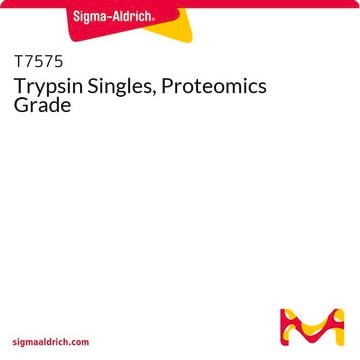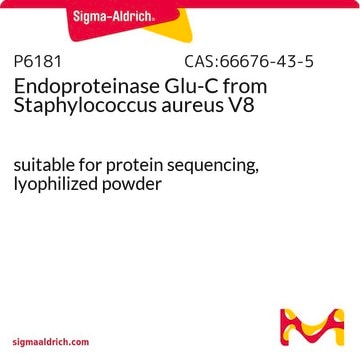EMS0008
LysargiNase
suitable for peptide or protein digestion insolution or in gel
Sinónimos:
LysargiNase mirrors trypsin for protein C-terminal and methylation-site identification
Iniciar sesiónpara Ver la Fijación de precios por contrato y de la organización
About This Item
Código UNSPSC:
41105331
NACRES:
NA.54
Productos recomendados
Categorías relacionadas
Descripción general
LysargiNase is a metalloproteinase found in the thermophilic archaea Methanosarcina acetivorans. It specifically cleaves before lysine and arginine residues in proteins. This cleavage results in peptides with molecular weights similar to tryptic peptides, but with N-terminal lysine or arginine residues that can be fragmented with b ion-dominated spectra. This can improve protein C-terminal peptide identification and several arginine rich phosphosite assignments. Unlike with trypsin, LysargiNase cleavage also occurs at methylated lysine and arginine, allowing detection of these epigenetic modifications.
LysargiNase is suitable for peptide or protein digestion in solution or in gel.
Aplicación
LysargiNase is suitable for peptide or protein digestion in solution or in gel.
LysargiNase is suitable for peptide or protein digestion in solution or in gel. It is active under a variety of solvent conditions including 5 mM TCEP, 5% methanol, 5% acetonitrile, 0.8 M urea, 0.1% RapiGest, 1% deoxycholate, 0.2% SDS and 1% NP-40. It is active up to 55°C at pH 6 – 9. LysargiNase is reversibly inhibited by 1, 10-phenanthroline, EDTA and other calcium and zinc chelating agents. For peptide or protein digestion, a ratio of between 1:100 to 1:20 (w/w) enzyme:substrate is recommended.
Componentes
Each vial contains 20 µg LysargiNase, prepared by recombinant expression in E. coli and lyophilized from buffer.
Forma física
Each vial contains 20 µg LysargiNase, prepared by recombinant expression in E. coli and lyophilized from buffer. Upon reconstitution in 20 µL water, the enzyme is in 50 mM HEPES, 5 mM CaCl2, pH 7.5.
Almacenamiento y estabilidad
Store the lyophilized product at -20°C for up to 2 years. After reconstitution, the unused material can be stored in the freezer in aliquots. Avoid repeated freeze thaw cycles.
Otras notas
Concentration: Please refer to lot specific datasheet.
Cláusula de descargo de responsabilidad
Unless otherwise stated in our catalog or other company documentation accompanying the product(s), our products are intended for research use only and are not to be used for any other purpose, which includes but is not limited to, unauthorized commercial uses, in vitro diagnostic uses, ex vivo or in vivo therapeutic uses or any type of consumption or application to humans or animals.
Palabra de señalización
Danger
Frases de peligro
Consejos de prudencia
Clasificaciones de peligro
Eye Irrit. 2 - Resp. Sens. 1 - Skin Irrit. 2 - STOT SE 3
Órganos de actuación
Respiratory system
Código de clase de almacenamiento
11 - Combustible Solids
Clase de riesgo para el agua (WGK)
WGK 1
Certificados de análisis (COA)
Busque Certificados de análisis (COA) introduciendo el número de lote del producto. Los números de lote se encuentran en la etiqueta del producto después de las palabras «Lot» o «Batch»
¿Ya tiene este producto?
Encuentre la documentación para los productos que ha comprado recientemente en la Biblioteca de documentos.
Le Zhang et al.
ACS chemical biology, 16(11), 2595-2603 (2021-11-05)
Methods for the selective labeling of biogenic functional groups on peptides are being developed and used in the workflow of both current and emerging proteomics technologies, such as single-molecule fluorosequencing. To achieve successful labeling with any one method requires that
Cynthia Tallant et al.
The Journal of biological chemistry, 281(26), 17920-17928 (2006-04-22)
The metzincin clan encompasses several families of zinc-dependent metalloproteases with proven function both in physiology and pathology. They act either as broad spectrum protein degraders or as sheddases, operating through limited proteolysis. Among the structurally uncharacterized metzincin families are the
Liana Tsiatsiani et al.
The FEBS journal, 282(14), 2612-2626 (2015-04-01)
Peptide-centered shotgun analysis of proteins has been the core technology in mass spectrometry based proteomics and has enabled numerous biological discoveries, such as the large-scale charting of protein-protein interaction networks, the quantitative analysis of protein post-translational modifications and even the
Kazuya Tsumagari et al.
STAR protocols, 2(3), 100682-100682 (2021-08-12)
Characterization of protein termini is essential for understanding how the proteome is generated through biological processes such as post-translational proteolytic events. Here, we introduce a practical protocol for terminomics to achieve simple and sensitive N- and C-terminal peptide enrichment. We
Pitter F Huesgen et al.
Nature methods, 12(1), 55-58 (2014-11-25)
To improve proteome coverage and protein C-terminal identification, we characterized the Methanosarcina acetivorans thermophilic proteinase LysargiNase, which cleaves before lysine and arginine up to 55 °C. Unlike trypsin, LysargiNase-generated peptides had N-terminal lysine or arginine residues and fragmented with b
Nuestro equipo de científicos tiene experiencia en todas las áreas de investigación: Ciencias de la vida, Ciencia de los materiales, Síntesis química, Cromatografía, Analítica y muchas otras.
Póngase en contacto con el Servicio técnico







